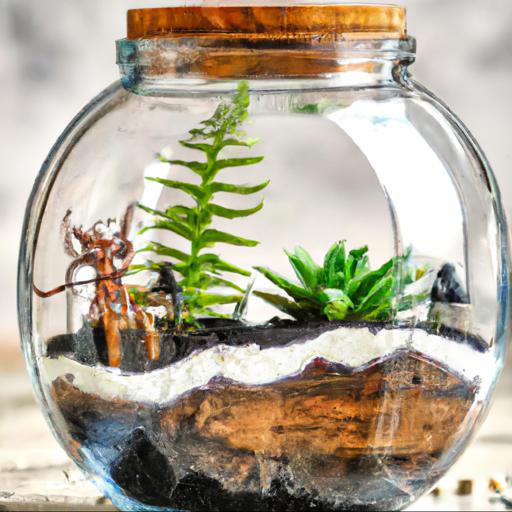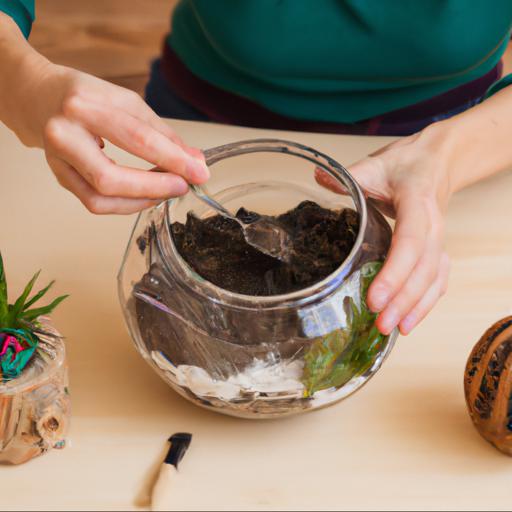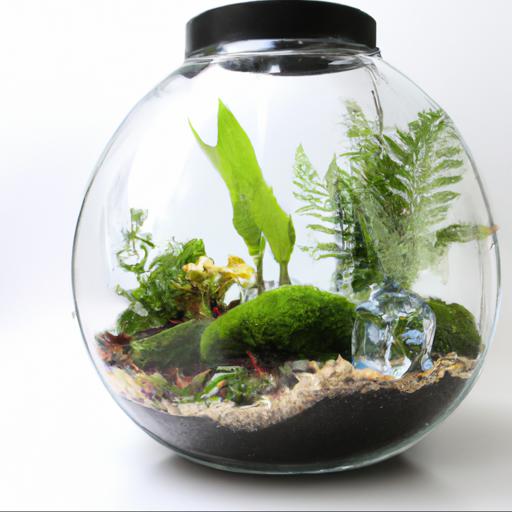Are you looking for a unique way to bring a bit of the outdoors inside your home? Look no further than these 11 terrarium ideas! Terrariums are a great way to add a touch of greenery to any space, and they’re easy to create and maintain.
Whether you prefer an open or closed terrarium, a hanging terrarium, or a terrarium with succulents, these 11 ideas will provide you with plenty of inspiration. Get ready to make your own terrarium and bring a bit of nature indoors!
11 creative terrarium ideas

As a UK garden expert, I can offer 11 creative terrarium ideas for people who want something unique in their garden. Terrariums are a great way to bring nature into any garden, providing a colourful and diverse micro-world to contemplate and explore.
A terrarium can be as small as a jam jar or as large as an almost life-size treehouse. With the right plants, soil and minerals, you can design a terrarium that is both beautiful and practical, a living piece of art with a unique and interactive ecosystem. For an especially creative design, why not try a floating terrarium?
It’s easy to do: all you need is a large container, some damp soil, a colourless aquarium gravel, and some floating aquatic plants. The plants will create a lush, underwater oasis right in your garden, showcasing some of nature’s most stunning flowers.
Another fun idea is to construct a tiny terrarium wall. Re-purpose a hanging planter, add a few climbing vines, and fill the box with drought-resistant succulents and air plants. This type of terrarium will create an eye-catching feature, whether hung inside the house or outside in the garden.
For something more exotic, why not try creating a miniature fossilized garden? Its easy to replicate the look by trapping tiny plants and stones in resin or plaster and letting it set.
You could even try to create an entire mini-ecosystem in your garden, getting imaginative with the organisms, landscape and materials you use. Those looking for something a bit more educational could try building a terrarium to learn about ecosystems. Start with a simple design, such as a large container with aquaponics, layers of soil and stones, and a few plants.
As your terrarium grows, you can experiment with different fish, and even breeding different types of plants and animals. You could also make a terrarium that features a hidden surprise inside. Plant a variety of bulbs, medusa heads and tiny mushrooms, and create a network of tiny pathways using terracotta shards, twigs and moss. Leave the lid open so that visitors can find the secret door and explore what lies beneath. Finally, why not get creative with a terrarium mantlepiece, a great way to bring a little bit of nature indoors and add a unique touch to any room. Start by choosing a large jar or pot, and then fill it with a variety of plants, stones and soil. To keep it attracting guests and changing the look, alternate moss, crystals and aquarium stones, and get creative with your plants. There are plenty of possibilities when it comes to designing creative terrariums – these are just a few of the possibilities. With a little bit of imagination and a healthy dose of soil, you’re bound to create something truly unique and special in your garden.
How to make a terrarium

As a UK garden expert, I frequently get asked by UK residents how they can make a terrarium at home. It’s a great way to cultivate your own mini garden indoors, and I’m here to answer all your questions! In this blog, I’ll take you through eleven incredibly simple terrarium ideas that will bring a green, natural touch to any home.
First, let’s talk about terrariums. A terrarium is essentially a miniature garden, constructed in a clear container such as a jar or fishbowl.
When creating a terrarium, you’ll need soil, pebbles, and the plants themselves, which are typically small and slow-growing. You’ll need to ensure that the container is filled with only a few inches of soil and moistened with just enough moisture to keep the plants alive.
The next step is to decide what type of terrarium you’d like to create. The type of plants, soil, and materials you choose will vary between the different types of terrariums. For instance, you might opt for a tropical style terrarium, featuring lush greenery and brightly coloured plants.
Or, you could create a woodland terrarium, which requires less maintenance and has a more natural aesthetic. Next, you’ll need to construct your terrarium.
You can set it up in any shape or size; the most popular shape is a sphere, which allows plenty of light and air to get to the plants. Once you’ve settled on the shape, begin by adding a layer of pebbles to the bottom of the container. This helps better drain excess water and give the plants the soil moisture they need.
Finally, add your plants. When selecting plants for your terrarium, pick species that thrive in humid environments and enjoy indirect sunlight. Make sure to pay attention to their positioning, as it will affect the microclimate inside the terrarium. Additionally, the terrarium should never be left in direct sunlight, as excessive heat and light will quickly dry out the soil. Now you know all about terrariums and have eleven ideas for crafting up your own little piece of paradise. With just a few simple steps, you can have a thriving mini-garden indoors in no time. So, get planting and enjoy the lushness of a terrarium in the comfort of your home!
Benefits of having a terrarium

;As a UK garden expert, I’m here to tell you the benefits of creating a terrarium. They are an amazing way of introducing foliage and beauty into your home, and can really brighten up dark corners and make even the smallest spaces more inviting. Here are 11 terrarium ideas to help you make the most of this living masterpiece:First, a terrarium is a great way to bring the outdoors in.
They’re a low maintenance way to add color and life to a room without any need for a green thumb. Plant life can purify the air, meaning you can enjoy fresh, clean air in your home without needing to do much work.
A terrarium also makes a great addition to any table, either as a bedside decoration or a centrepiece. Second, terrariums can make a great addition to any office space.
Not only do living plants bring a calming element to a desk but the terrarium itself acts as a mini ecosystem, allowing you to see nature in action. You can even get creative and turn larger terrariums into miniature gardens, growing your own herbs and spices or small flowers. Third and finally, terrariums are ideal for those who are constrained for both space and time.
As terrariums are self-contained, they are low-maintenance and require minimal effort and maintenance to keep them healthy. This makes them perfect for those of us who don’t have the time or energy to take on the upkeep of a regular garden. Overall, there are many ways to enjoy the beauty and benefits of having a terrarium.
Whether you use it to purify the air, bring a touch of greenery to your office, or simply to enjoy nature’s beauty in miniature, a terrarium really can brighten up any space.
Tips for maintaining a terrarium
As a UK garden expert, I must say that the topic of terrariums is one of the most exciting ones out there. Creating and maintaining a thriving terrarium is a great way to combine the beauty of nature with the convenience of a home environment.
For those looking for unique and creative terrarium ideas, here are 11 ideal tips for maintaining a terrarium. Start by creating a terrarium that is both aesthetically and functionally illuminated, be it canopied or open.
Start with an appropriate container, such as a terrarium globe, a jar or a glass bowl, that is partially or fully see-through. Opt for an appropriate glass or plastic container with a wide and/or shallow rims to ensure plenty of room for light and ventilation.
Once the container has been selected, fill the bottom with a layer of gravel or stones. This layer will ensure adequate drainage for the plants.
When adding the soil, it’s important to ensure that it is specific for terrariums in order to provide a healthy growing environment for the plants. The soil should also be light and airy, as this is key for optimal water retention and oxygen levels.
When selecting terrarium plants, it is essential to make sure that they are compatible, meaning that they have the same needs in terms of lighting, humidity, and soil. Generally, terrarium plants that are moisture-loving, such as ferns, mosses and some succulents, tend to prefer a humid environment.
Structure and design of one’s terrarium is also key, opt for plants with complementary sizes, colours and textures. In addition, It is essential to provide adequate lighting to your terrarium. The amount and type of lighting will vary depending on the type of plants. Some terrariums do well with direct sunlight, however, it is important to remember that terrarium plants tend to dry out quickly in high light situations, so it is advised to reduce the amount of direct sun exposure (as well as filter sunlight for other terrariums). Artificial lighting can also be a great option, since LED light bulbs are relatively inexpensive and consume less energy. Finally, as with any garden, watering and fertilizing are key components to maintain a thriving terrarium. As always, it is important to check on the humidity and temperature levels of the terrarium and to adjust the watering amounts accordingly. In addition, choose a fertilizer with a balance of nitrogen, phosphorus and potassium to provide the terrariums nutrients. And lastly, ensure the soil is not over-fertilized, as high nitrogen levels can damage the plants. By following these eleven tips, you will be able to create a thriving terrarium with ease. With a little know-how and dedication, you can create a beautiful, lush and healthy environment for your terrarium plants.
Our video recommendation
Bottom Line
This article provides 11 terrarium ideas to help you create a unique and beautiful living space. From simple hanging terrariums to wall-mounted glass containers, there are plenty of creative ways to bring nature indoors. With these ideas, you can create a unique and stylish terrarium that will add a touch of greenery to your home.
FAQ
What materials are needed to make a terrarium?
To make a terrarium, you will need a glass container, soil, rocks, activated charcoal, plants, and decorations (optional).
What types of plants are best suited for a terrarium?
Terrariums are best suited for small, slow-growing plants that thrive in humid environments, such as ferns, mosses, and succulents.
How often should a terrarium be watered?
A terrarium should be watered every 1-2 weeks, depending on the type of plants and the size of the terrarium.
How much light does a terrarium need?
A terrarium typically needs indirect sunlight, such as a few hours of bright, indirect light each day.
What are the benefits of having a terrarium?
The benefits of having a terrarium are that it is a low-maintenance, self-sustaining ecosystem that can be used to grow plants indoors. It is also a great way to bring nature indoors and can help to purify the air in your home. Additionally, terrariums can be used to create a unique and beautiful decorative piece in any room.
How can a terrarium be decorated?
A terrarium can be decorated with rocks, pebbles, soil, sand, moss, and other small plants. It can also be decorated with figurines, shells, and other small decorative items.

